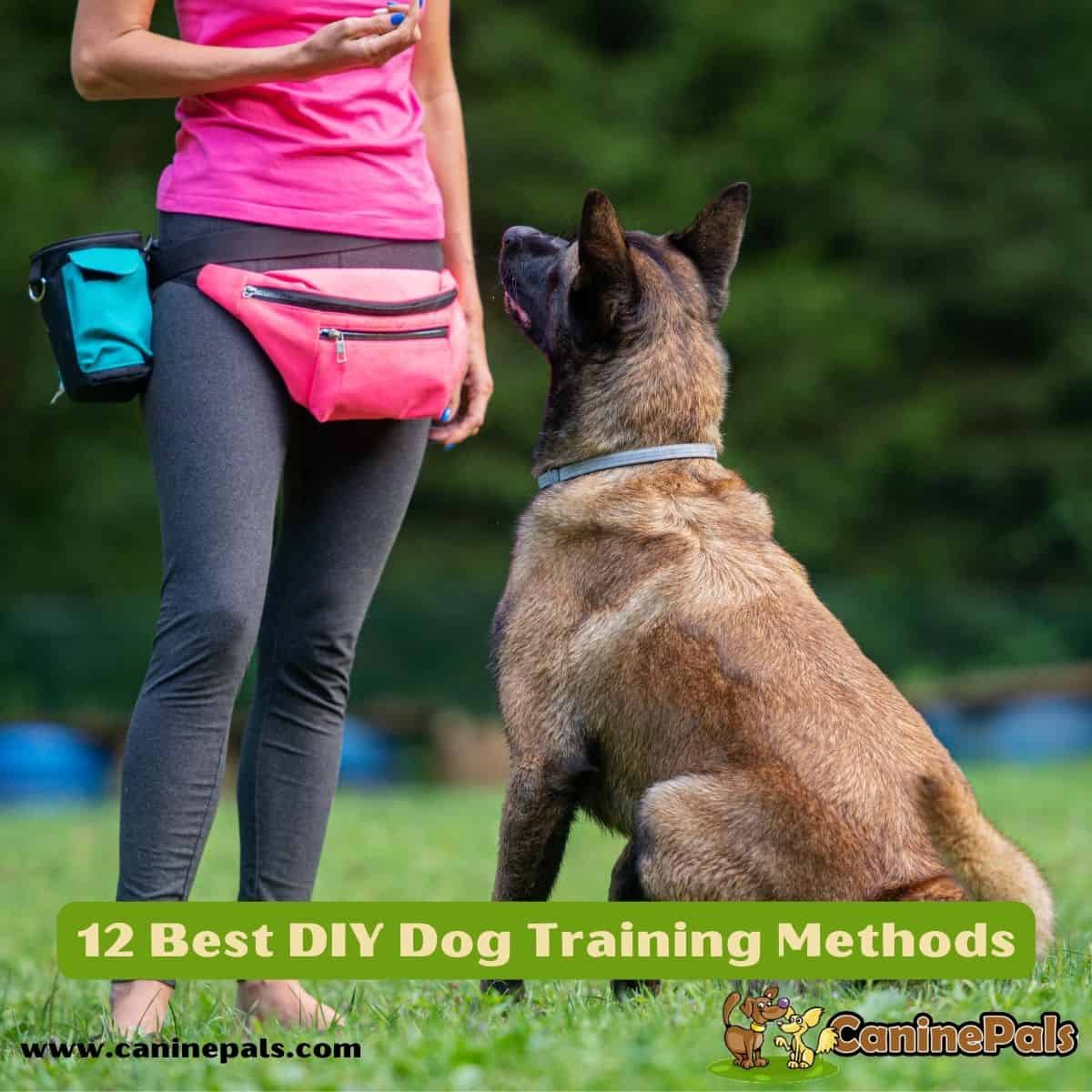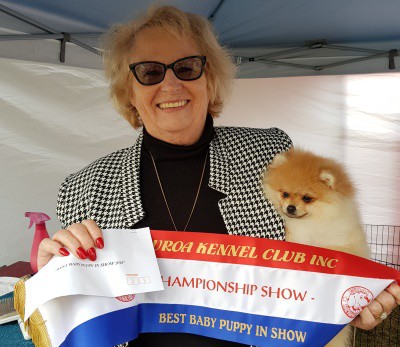Last Updated on March 20, 2024 by Denise Leo. Post first published on February 2, 2023.
Why not give DIY dog training a go? It’s an easy way to get the hang of things, and maybe you can make your pup more well-trained in no time at all without the help of a professional dog trainer. It is essential to commence the positive reinforcement training process with your puppy as soon as possible.
Regardless of what kind of pup you own, a dog training program is essential. Your puppy needs it to learn basic commands, how to bark at the mailman, and sit when they’re told so that one day soon, he can be a good citizen.
The time for getting started on proper obedience has never been riper; with today’s technology-heavy lifestyle, many rely heavily upon their pets as working partners or even therapy animals.
Proper socialization and proper behavior are among the basics for all dogs, but it’s especially vital in puppies who have not yet learned how society works. If you’re ready to get started on this journey with Fido, then be sure to check out our blog post.
DIY Dog Training Quick Facts
- DIY dog training is an easy and effective way to help your pup become a well-trained companion.
- Training should be positive, upbeat, and enjoyable for you and your pup.
- Basic obedience training commands like “sit” or “stay” are essential for all dogs.
- Positive reinforcement using treats or praise can motivate good behavior in dogs during training sessions that should remain short but frequent.
- Teaching complex tasks such as walking off the leash will require draining some energy beforehand to set themselves up for success when they respond correctly with rewards given within half a second of the command being issued.
- End each session on a positive note by rewarding him with something he enjoys, such as food, petting, or attention, so that he understands the link between good behavior and reward before moving on to more complicated aspects of puppy training, which also involve shaping his responses into what you expect from him over time while gradually weaning them off food treats until they obey without needing them at all times even if there are distractions around tempting them away from obeying you!

DIY Dog Training List
Fun Dog Training Program
Training must be enjoyable for your dog and also for you. If you’re not in a good mood, don’t bother because your dog will know. Sessions should only be a short time so your dog will remain motivated.
Don’t reward him if he doesn’t respond properly when you give a command several times. Then try again but use an easier command. Go back to the more challenging task a bit later.
Always finish the training positively. Give a command you already know he will always obey. Then reward him for doing it well and finish commands such as “release” or “free.” Don’t use ordinary words like “okay.”
You and your dog should feel like you have achieved something at the session’s end.
Teaching Dog Basic Obedience Commands
All dogs should know the most basic of obedience commands. You can add: stop it, leave it, enough, leave it, or cease. Remember that a dog is less motivated as the tasks grow more complicated.
Your success rate will depend on how sophisticated the command is and how motivated your dog will be to respond. Look at it from your dog’s point of view. Is it more appealing to chase that squirrel or return to you? Understanding this will greatly improve your patience and the level of success you reach.
Dog training techniques should never contain any punishment or negative elements of training. You can’t hit, hang, chain jerk, yell, and never use an electric shock. Every training period should be positive, happy, and upbeat, and reward your dog for things he does well. PUNISHMENT is NOT the opposite of reward; it’s NO reward.
Ignore wrong responses from your dog, and if he fails to respond, he gets no rewards. Positive reinforcement is the only way to train dogs. Most dogs are keen to make their owners happy and to receive valued resources such as food, toys, and attention.
Positive Reinforcement Training
The biggest reward you give your dog must be one he gets for doing well during training. If the reward is food, it’s better to train prior to his meal and not after he has eaten.
If you use petting, praise, and other elements of your focus as rewards, have a positive reinforcement training session when your dog craves your attention. An example would be if you just got home from work.
Dog walking rules can include on and off-leash behaviors. If you plan complicated aspects of training, such as him not being on the leash and you use the “down-stay” command, ensure you have already given him moderate exercise to drain some of his energy. Then it will be easier to make him stay in a reclining position and avoid setting yourself up for failure in the early training stages.
Good Treats to Give Dog When Training
Using food as a reward will work if it’s your dog’s favorite food. Dogs motivated by food will perform better than if it isn’t used. Freeze-dried liver and small bits of cheese are usually favorites, but you know your dog, so choose his favorites. You aim to be strong as you motivate your pet to obey all commands so he gets a delicious treat.
If food treats are used, they MUST be very small, about the size of the fingernail of your smallest finger. The food’s texture should be easy to digest, not need chewing and not crumble so it won’t make a mess.
If any of these things happen, your dog’s attention will be distracted as he licks up every crumb he can find. Never use large foods as treats because they take much longer to consume, and concentration is lost.
Puppy Training Treats
Details of some of the better puppy training treats available on Amazon:

Dog Training With Treats vs. Praise
If you intend to vocalize praise for a reward, do it in a singsong tone of voice instead of using a treat, as this is very pleasant for dogs. Make sure your voice is enthusiastic because that lifts the dog’s mood. If you pat him, choose the best options he likes. This includes tummy rubs, parting the dog behind his ears, and gently stroking his face.
Note: Most dogs dislike patting their heads, so find out if this describes your dog.
It would be best if you timed the reward for the best advantage. If your dog has done as you wanted, reward him within half a second of that command, so your dog understands the link between good behavior and the reward for doing so.

Using Dog Training Commands
When choosing a word, only say it once. Examples include: off, out, quiet, sit, leave it, down, and quiet. A dog can remember your command for approx two minutes before forgetting it. Short words are ideal for most commands.
There’s only one command with three words. The first is your dog’s name. As an example, his name is ROVER. Then you’ll say a one or two-word command—for example, ROVER. Then you say the name or another syllable. For example, Rover! Then “SIT.”
Put the leash on your dog and get his focus, so he’s looking right at you while you’re looking right at him. Then use an action word such as SIT.
A dog that’s not trained very well may slowly sit and, when he does, quickly reward him with praise…Say, GOOD BOY, ROVER. Also, remember to say it with all your heart and in a high tone whilst simultaneously rewarding him.
If a dog hasn’t been trained, you’ll need to help him sit by holding a snack above him and making him sit before he gets it. Praise him and give him the food if you’re successful with this. If he doesn’t sit, you may have to put extra tension on his collar or push his rump down.
Once your dog is doing what you want more than 85% of the time while training him in a quiet environment, the next stage should commence. This is where you shape his behavior toward the response you expect from him. You may reward him for sitting faster…say within 3 seconds, then 2 seconds, and finally 1 second or straightaway.
Choose the positive reinforcement reward before issuing the command. Another option is to give him positive reinforcement rewards if he sits for more definite, longer periods so he can’t just touch his rear to the ground to win the treat. Make sure he’s firmly sitting before giving him any reward, and you can slowly make the time length between when he sits and when he’s rewarded for that.
Work on gradually boosting the time your dog must stay in an SIT-STAY position, and he can relax for a minute while you’re five feet from him. Slowly increase the time gap from the sitting to the rewarding when he has achieved each goal successfully 5-10 times. If you use long sitting periods, the reward can be given intermittently during this time (at least during his training period.)
Use easy words such as STEADY or EASY to teach him to associate exercise with relaxation. You should also use a release command which can be RELEASE or FREE, because these will let the dog know when he has done what you wanted for enough time.
It’s important to vary the basic commands you use during any training period and keep the sessions short but have lots of them. Dogs learn better during short training times that are regular as compared to longer, infrequent sessions.
After he has learned some useful basic obedience commands during the continuous rewarding schedule (i.e., where he gets rewarded each time he does what is asked of him), it’s time not to reward him all the time.
Start with twice out of each three training sessions and then every third period of training. Then it would be best if you only rewarded him occasionally. That’s how he gets weaned off food treats and will stop your dog from only obeying when he gets a treat. Remember that it’s still vital to praise your dog every time he does what’s asked of him, regardless of whether other rewards are to be given.

How to Get a Dog to Obey
To succeed in dog training, your dog must understand you are the leader of his pack. This means giving your dog clear, consistent commands that it understands and can follow without confusion or hesitation. When teaching a dog new commands, please keep it simple and then layer on more complex tricks.
When teaching the basics of dog obedience, like sitting down or staying calm, try using food as motivation by rewarding him with tidbits from your hand when doing well during these exercises.
After puppy training has been successfully achieved in quiet environments, it’s time to carry out more training in places with numerous distractions.
Keep puppy training in the yard, using his leash, but slowly making it longer and eventually not using it at all, but he still obeys you without having his leash on. Training in busy environments is a good idea because it will test your control when he’s distracted.
The ideal scenario is to have your dog obey you always without needing the leash, even if distractions may be tempting. Essential rules for dog owners include always ending a dog training session with something positive. Then your dog will come to expect that to happen.
This level of your dog’s training will work, but it will take a lot of time and hard work from you and your beloved pet. This is certainly a worthy objective.

DIY Dog Training Guidelines Conclusion
So now you know the basics of DIY dog training and, hopefully, understand why it is so important. CaninePals wants to help you be successful with your new pup by providing helpful information that will make a difference in how well-trained your puppy is.
With these tips, we hope this process will go as smoothly as possible for you and your furry friend! If you need more advice or guidance at any point during this process, please reach out; our team would love to provide whatever support we can. Good luck on your journey toward becoming an expert dog trainer yourself!
Copyright CaninePals.Com. All Rights Reserved.
References and Further Reading:
American Kennel Club.
English Kennel Club.
Australian National Kennel Council.


